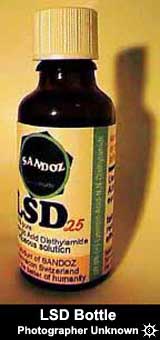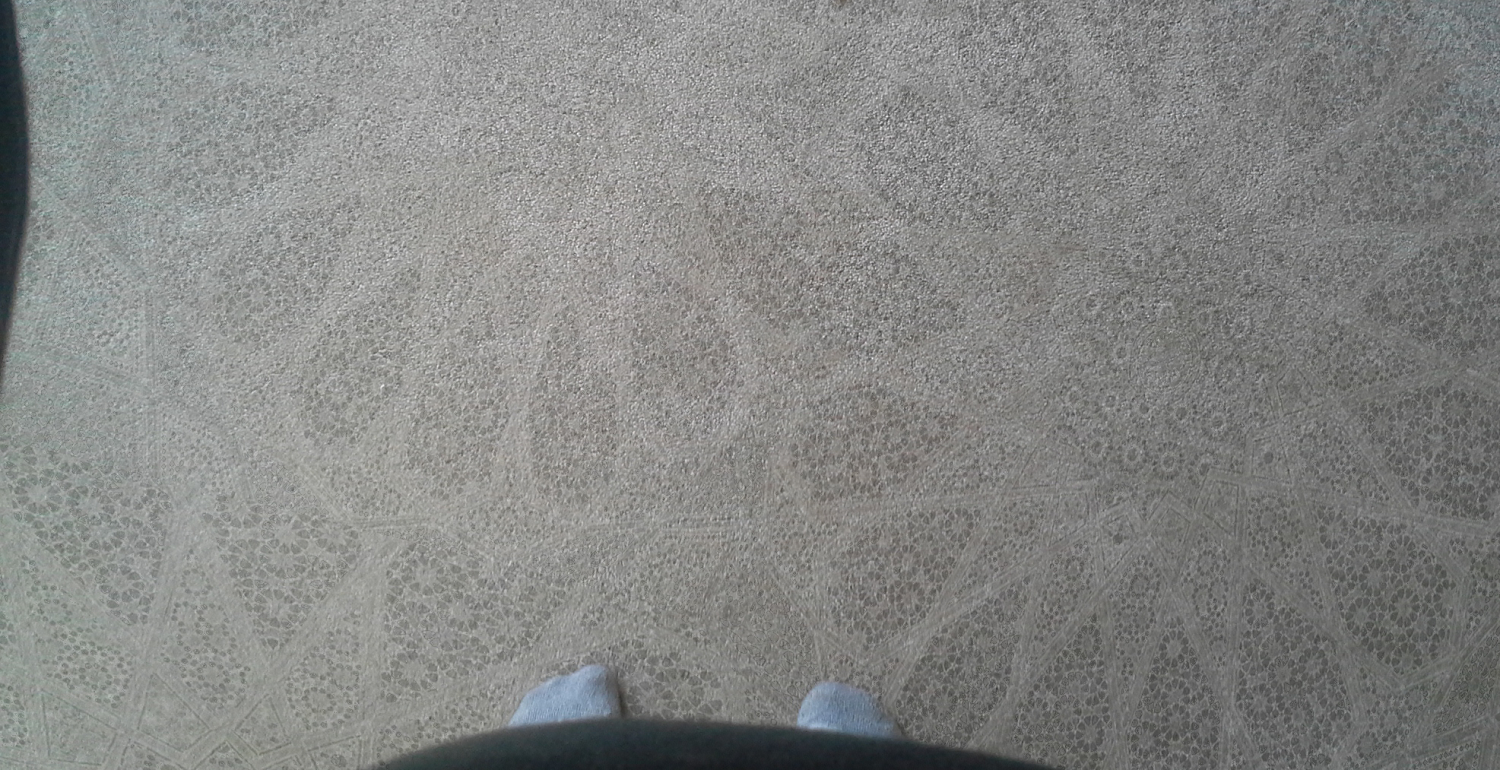LSD: Difference between revisions
| (8 intermediate revisions by 4 users not shown) | |||
| Line 1: | Line 1: | ||
[[File:Lsd_bottle.jpg|thumb| | [[File:Lsd_bottle.jpg|thumb|left]] | ||
'''Lysergic acid diethylamide''', abbreviated LSD or LSD-25, also known as lysergide (INN) and colloquially as '''acid''', is a semisynthetic psychedelic drug of the ergoline family, well known for its psychological effects which can include altered thinking processes, closed and open-eyed visuals, synesthesia, an altered sense of time and spiritual experiences, as well as for its key role in 1960s counterculture. It is used mainly as an entheogen, recreational drug, and as an agent in psychedelic therapy. LSD is non-addictive, is not known to cause brain damage, and has extremely low toxicity relative to dose. However, acute adverse psychiatric reactions such as anxiety, paranoia, and delusions are possible. | '''Lysergic acid diethylamide''', abbreviated LSD or LSD-25, also known as lysergide (INN) and colloquially as '''acid''', is a semisynthetic psychedelic drug of the ergoline family, well known for its psychological effects which can include altered thinking processes, closed and open-eyed visuals, synesthesia, an altered sense of time and spiritual experiences, as well as for its key role in 1960s counterculture. It is used mainly as an entheogen, recreational drug, and as an agent in psychedelic therapy. LSD is non-addictive, is not known to cause brain damage, and has extremely low toxicity relative to dose. However, acute adverse psychiatric reactions such as anxiety, paranoia, and delusions are possible. | ||
| Line 9: | Line 9: | ||
== Dosage == | == Dosage == | ||
{{#tdose: lsd}} | |||
{ | |||
== Duration == | == Duration == | ||
| Line 59: | Line 50: | ||
* Nausea | * Nausea | ||
* Dizziness | * Dizziness | ||
* Vasoconstriction | |||
=== After effects === | === After effects === | ||
| Line 70: | Line 62: | ||
See [[Psychedelics#Harm_Reduction|Psychedelic Harm Reduction]] for general information. | See [[Psychedelics#Harm_Reduction|Psychedelic Harm Reduction]] for general information. | ||
= Chemistry and Pharmacology = | == Chemistry and Pharmacology == | ||
Chemical name: 9,10-Didehydro-N,N-diethyl-6-methylergoline-8ß-carboxamide | Chemical name: 9,10-Didehydro-N,N-diethyl-6-methylergoline-8ß-carboxamide | ||
The mental effects of | The mental effects of LSD can be rapidly reversed by the IM administration of 50 mg chlorpromazine. | ||
=== LD50 === | === LD50 === | ||
The LD50 | The LD50 has not been determined, but some estimates suggest doses higher than 10mg (10,000 µg) may be fatal | ||
=== Reactivity === | === Reactivity === | ||
| Line 87: | Line 79: | ||
Hazardous polymerization has not been reported to occur under normal temperatures and pressures. | Hazardous polymerization has not been reported to occur under normal temperatures and pressures. | ||
= Legal status = | == Legal status == | ||
LSD is illegal to possess for recreational purposes in most nations. This includes the US, Canada, Mexico, Finland, Germany, Greece, Italy, the Netherlands, Belgium, Sweden, New Zealand, Australia, Norway, Portugal, Russia, UK, and Brazil. | LSD is illegal to possess for recreational purposes in most nations. This includes the US, Canada, Mexico, Finland, Germany, Greece, Italy, the Netherlands, Belgium, Sweden, New Zealand, Australia, Norway, Portugal, Russia, UK, and Brazil. | ||
| Line 93: | Line 85: | ||
Some exceptions are made in nations where it is used in legitimate research, such as Russia. A license is required. | Some exceptions are made in nations where it is used in legitimate research, such as Russia. A license is required. | ||
= Links = | == Links == | ||
* [http://www.erowid.org/chemicals/lsd/lsd.shtml Erowid] | * [http://www.erowid.org/chemicals/lsd/lsd.shtml Erowid] | ||
* [https://en.wikipedia.org/wiki/LSD Wikipedia] | * [https://en.wikipedia.org/wiki/LSD Wikipedia] | ||
* [http://www.maps.org/research/ | * [https://tripsafe.org/lsd/ TripSafe] | ||
* [http://www.maps.org/research-archive/w3pb/2008/2008_Passie_23067_1.pdf The Pharmacology of Lysergic Acid Diethylamide: A Review] | |||
[[Category:Psychedelic]] | [[Category:Psychedelic]] | ||
[[Category:Drugs]] | [[Category:Drugs]] | ||
Latest revision as of 23:05, 10 July 2017

Lysergic acid diethylamide, abbreviated LSD or LSD-25, also known as lysergide (INN) and colloquially as acid, is a semisynthetic psychedelic drug of the ergoline family, well known for its psychological effects which can include altered thinking processes, closed and open-eyed visuals, synesthesia, an altered sense of time and spiritual experiences, as well as for its key role in 1960s counterculture. It is used mainly as an entheogen, recreational drug, and as an agent in psychedelic therapy. LSD is non-addictive, is not known to cause brain damage, and has extremely low toxicity relative to dose. However, acute adverse psychiatric reactions such as anxiety, paranoia, and delusions are possible. LSD is the best known and most researched psychedelic. It is the standard against which all other psychedelics are compared. It is active at extremely low doses and is most commonly available on blotter or in liquid form.
History
First synthesized by Albert Hofmann on November 16, 1938, LSD went on to become a staple of the psychedelic world and the centerpiece of the 1960s counterculture. On April 19, 1943, Hofmann returned to investigate LSD further and ingested 250 micrograms of LSD. Hofmann believed this dose to have a minuscule, threshold effect. He rode his bicycle home and later wrote that, "... little by little I could begin to enjoy the unprecedented colors and plays of shapes that persisted behind my closed eyes. Kaleidoscopic, fantastic images surged in on me, alternating, variegated, opening and then closing themselves in circles and spirals, exploding in colored fountains, rearranging and hybridizing themselves in constant flux ..." This day in history later became known as Bicycle Day and is celebrated by LSD enthusiasts as the world's first LSD trip.
Dosage
{{#tdose: lsd}}
Duration
Note: Duration can be significantly longer with higher doses.
| Onset | 30-120 minutes |
| Total | 8-12 hours |
Effects
Positive
- Mood lift, euphoria, sense of well being
- Closed and open eye visuals, including the saturation of colors, tracers, etc.

- Enhanced audio/tactile senses
- Increase in associative & creative thinking; introspection
- At high doses, feeling of 'oneness' with everything; ego death
Neutral
- Racing thoughts, thought loops
- Extreme pupil dilation; increased sensitivity to light
- Inability to focus
- Slight increase in body temperature and heart rate
- Time dilation; seconds feel like minutes, minutes like hours
Negative
- Tension
- Anxiety, restlessness, confusion
- Insomnia
- Nausea
- Dizziness
- Vasoconstriction
After effects
User may feel "out of it" and generally off the day after, esp. with larger doses. Residual euphoria and a "ready to take on the world" feeling may persist. No bodily harm from recreational doses of LSD, though mental effects from long term chronic use can be negative in some people.
Harm Reduction
LSD is regarded as being an extremely safe psychedelic, being almost impossible to overdose on. However, although extraordinarily uncommon, a few cases have been reported in the medical literature of dangerous overheating following ingestion of large amounts of LSD, including one non-fatal case that brought the patient's body temperature to over 106°F (41°C). LSD may also cause dangerous physiological and psychological reactions when used in conjunction with lithium or tricyclic antidepressants.
See Psychedelic Harm Reduction for general information.
Chemistry and Pharmacology
Chemical name: 9,10-Didehydro-N,N-diethyl-6-methylergoline-8ß-carboxamide
The mental effects of LSD can be rapidly reversed by the IM administration of 50 mg chlorpromazine.
LD50
The LD50 has not been determined, but some estimates suggest doses higher than 10mg (10,000 µg) may be fatal
Reactivity
Stable for moderate periods of time under normal temperatures and pressures. Thermal decomposition products of LSD when stored in massive quantities may include dangerous amounts of toxic oxides, carbon, and nitrogen. Long-term storage of LSD should be done by limiting exposure to heat, light, and air; eg. wrapped in aluminium foil, vacuum sealed, and placed in a freezer or refrigerator.
Polymerization
Hazardous polymerization has not been reported to occur under normal temperatures and pressures.
Legal status
LSD is illegal to possess for recreational purposes in most nations. This includes the US, Canada, Mexico, Finland, Germany, Greece, Italy, the Netherlands, Belgium, Sweden, New Zealand, Australia, Norway, Portugal, Russia, UK, and Brazil.
Some exceptions are made in nations where it is used in legitimate research, such as Russia. A license is required.